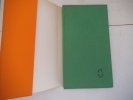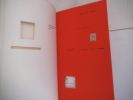VANNI Gian Berto/LOWELL.A SIFF
Love
petit in 8 étroit pleine toile verte d’éditeur,jaquette orange avec titre illustré,texte,découpages,collages, papiers transparents,papiers de couleurs,Les découpes laissent apparaître les images des pages qui suivent etc.. Tisné éditeur 1er Août 1964 très bon état Edition originale du premier livre du peintre Gian Berto VANNI,né à Rome en 1927.Professeur d’art à la Cooper Union School of Art de New York,VANNI imagine un livre de découpages en sérigraphie. Chaque page de papier fort de différentes couleurs comporte fenêtres et découpages de formes variées ouverts sur la suite de l’ouvrage. Illustration minimaliste légendées par quelques phrases en anglais autographiées en petits caractères, imprimée uniquement en recto,seule la traduction françaisefigure sur le verso blanc de la feuille.Extraordinaire livre d’artiste pour enfant,innovant et surprenant
Reference : 2224
Bookseller's contact details
Charbonnel
M. Sylvain Charbonnel
2, rue du Champ de Mars
55000 Bar le Duc
France
03 29 79 40 63
Payment mode

Sale conditions
Les commandes se font de préférence par e-mail ou par courrier.Tous les livres proposés sont en bon état sauf indications contraires mentionnées dans la description.Les prix sont nets,port en sus à la charge du destinataire.Les envois,après entente concernant les frais de port pour la France s'effectuent dès réception par chèque bancaire,mandat ou virement bancaire.Pour la zone euro par virement bancaire. Me demander mon RIB-IBAN-BIC.Hors Europe Règlement par carte bancaire accepté uniquement par l'intermédiaire de pay pal,les frais sont à la charge de l'acheteur.Les livres voyagent aux risques et périls du destinataire,l'emballage soigné est gratuit.Afin d'éviter tout litige il est expressément conseillé l'envoi en recommandé.Passé un délai d'une dizaine de jours à partir de la date de commande,les ouvrages non réglés seront remis en vente.
5 book(s) with the same title
Werner Mannaers Love letters.
Antwerpen, MER Paper Kunsthalle, 2012 Gebonden, Hardcover, 296 pagina's met illustraties in kleur, 30x21 cm, ISBN 9789490693893.
Een liefdesbrief geeft vorm aan de liefde. Mannaers schrijft er geen, hij schildert ze in zijn smeuige bad painting-stijl. Gedurende een periode heeft hij elke dag een Love Letter gemaakt en bestemd. De bestemmeling is een vrouw. Mannaers is tevens verliefd op de liefde, dat maakt zijn reeks algemeen menselijk. Kunstenaars kunnen niet zwijgen over (hun) kunst, ook als ze de liefde bedrijven. Zo is het boek Love Letters een visueel commentarierend beeldverhaal over de geschiedenis van de moderne kunst geworden. Het werk van Mannaers is steeds 'intertekstueel', d.w.z. dat in of onder een tekst er een andere schuilt. In zijn Love Letters vinden we een dubbel niveau van twee soorten gelaagdheden. Zijn schilderijen zitten vol referenties aan andere kunstenaars. Voor zijn dagelijkse Love Letters, gouache op papier, plukt hij hier en daar uit zijn eigen schilderijen die in de maak zijn. Lieftalliger met minder weerhaken. // Love letters shape love. Werner Mannaers doesn?t write love letters, he paints them in his characteristic ?bad painting? style. During a certain time span, the painter created a Love Letter each day; the recipient of which was always a woman. Mannaers is in love with love; which makes his current series especially human: artists never shut up about (their) art, even when making love. The book Love Letters groups these paintings Mannaers made over time. Each Love Letter is effectuated using gouache on paper. They refer to some of Mannaers? paintings that are currently in the making. Each Love Letter equally makes reference to other artists. This makes this publication more than a collection of recent Love Letters: the publication discreetly evolves towards a visual commentary on the history of modern art.
Strategies of Passion Love and Marriage in Medieval Iceland and Norway,
Turnhout, Brepols, 2005 Hardback, XIV+345 p., 160 x 240 mm. ISBN 9782503521633.
This book is concerned with the social and gendered meanings of love in medieval Norway and Iceland. In the Viking Age, to love would most often imply a submissive social position, while being loved by a woman could elevate a man above the status of her family. Women were supposed to love upwards in the social hierarchy, but could also use their desire to negotiate the social position of men. A close reading of the skaldic poetry shows the dilemma men faced when longing for women's love and approval. These ideas of love relations shaped Norse interpretations of courtly love and marriage formation by consent in the twelfth and thirteenth centuries. However, new ideas of sexuality, gender and aristocratic culture changed several aspects of love and marital affection in the later middle ages. Men became the loving subject, but in a way that did not challenge the social order. For women, ideal love was attached to humility and submission to parents and husband. But even though the new ideology of love and marriage to some extent neutralized the tensions between consent and parental control, the sources show that both men and women could use the new conceptions of love to serve their own marital and social strategies. Languages : English.
Reference : albaa9e2329ba05a769
Belshe V. Pimenova. Love in Nature. A History of Loves Development. In 3 Parts (
Belshe V. Pimenova. Love in Nature. A History of Loves Development. In 3 Parts (in one cover) In Russian (ask us if in doubt)/Belshe V. Per. E.K. Pimenovoy. Lyubov v prirode. Istoriya razvitiya lyubvi. V 3-kh chastyakh (v odnom pereplete) Short description: In Russian (ask us if in doubt).The author deals with the history of marriage free love the struggle for the liberation of women and other piquant topics related to the relationship between sex and marriage. The facts are taken from the field of physiological and zoological research in the late nineteenth and early twentieth centuries. The author in a philosophical fiction examines sensual and spiritual love sexual attraction the miracle of creation the origin of man from the ape the social ideal of love love and creativity love in the zoological and insect worlds analyzes the conflict between love and violence understands the role of social in the creation of feelings the division of labor in love gives the historical resolution of the act of fertilization reflects on the future of love discusses the basic biogenetic law and much more. We have thousands of titles and often several copies of each title may be available. Please feel free to contact us for a detailed description of the copies available. SKUalbaa9e2329ba05a769
A methode unto mortification: called heretofore, the contempt of the world, and the vanitie thereof Written at the first in the Spanish. - [A SOURCE FOR SHAKESPEARE'S ""LOVE'S LABOUR'S LOST""]
London, Iohn Windet, 1608. 12mo. In contemporary full calf. Small paper-label pasted on to top of spine. Wear to extremities, corners bumped. Edges of boards with loss of leather. Previous owner's names to front and back end paper (""Robert Wilson"" & ""Edvard Wilson, anno domini 1666""). Internally with a few light dampstains. (20), 328, 328-499, (4) pp.
The exceedingly rare second edition (the first being from 1586) of Roger’s somewhat free translation of ‘Papist’ Diego de Estalla’s work “Libro de la vanidad del mundo (Toledo, 1562). Roger’s admit that he had no access to the original but had to use the Itanlian and Spanish translations. This present English translation, however, is of significant interest since recent research suggests it was a source and inspiration for Shakespeare’s ‘Love’s Labour’s Lost’: At the opening of ‘Love’s Labour’s Lost’, the vow to renounce worldly pleasure has barely been announced before one of Navarre’s book-men declares his success: “Dumaine is mortified” (I.i.28). This ‘mortified’ is not a word Shakespeare would use often. It appears here in the sense of ‘having the appetites and passions in subjection’ and insensible or impervious to (the world and its pleasures), the latter informing Dumaine’s gloss: ‘To love, to wealth, to pomp. I pine and die’. The fact that this is the earliest use of ‘mortified’ in the Shakespearean canon is the first clue that one of the sources for Love’s Labour’s Lost was Thomas Roger’s A Methode unto Mortification, published in London in 1586 and again in 1608. Shakespeare’s pleasure in frustrating the ambitions of this book went some way to shaping his play”. (Kingsley-Smith, A Method unto Mortification: A New Source for Love’s Labour’s Lost). ""Love's Labour's Lost"" is one of William Shakespeare's early comedies, believed to have been written in the mid-1590s. The play revolves around the King of Navarre and three of his noble companions who make a pact to swear off women and focus on scholarly pursuits for three years. However, their resolve is tested when the Princess of France and her entourage arrive on a diplomatic mission. Each of the men falls in love with one of the women, leading to a series of comedic misunderstandings, romantic entanglements, and wordplay. “It is also possible that some facts about the original author sparked Shakespeare’s interest. Diego de Estella was born in Navarre, and spent time the court of Philip II of Spain before incurring disapproval for his criticism of court life and being forced into a Franciscan monastery. Armado, the braggart and clown of Love’s Labour’s Lost, is the first Spaniard to appear in Shakespeare”. (Kingsley-Smith, A Method unto Mortification: A New Source for Love’s Labour’s Lost).
DISQUE VINYLE 33T : LOVE STORY - Theme From Love Story, Snow Frolic, Mozart: Sonata In F Major (Allegro), I Love You, Phil, The Christmas Trees, Search For Jenny (Theme From Love Story), Bozo Barrett (Theme From Love Story), Skating In Central Park...
"PARAMOUNT. 1970. In-12. Broché. Etat d'usage, Couv. convenable, Dos satisfaisant, Intérieur frais. Pochette en couleurs. Musica de la banda original del sonido de la pelicula ""Historia de Amor"". Theme From Love Story, Snow Frolic, Mozart: Sonata In F Major (Allegro), I Love You, Phil, The Christmas Trees, Search For Jenny (Theme From Love Story), Bozo Barrett (Theme From Love Story), Skating In Central Park, The Long Walk Home, J.S. Bach: Concerto No. 3 In D Major (Allegro), Theme From Love Story - Finale.. . . . Classification : 410-33 Tours"
Disque n° ECI 55. Classification : 410-33 Tours
 Write to the booksellers
Write to the booksellers










